Kurdish Refugee & IDP Camps (Part I)
Jun 16, 2009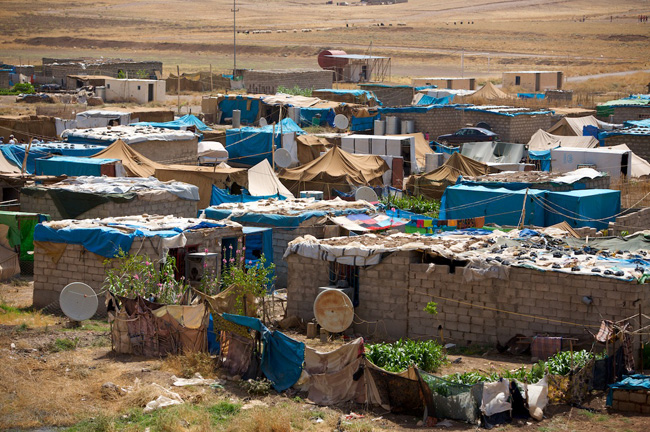
Above: Akre District, Iraq - Grdasin IDP Camp - A view of the Grdasin IDP Camp. The camp was established in 2006 for Kurds forced to flee Mosul due to increased threats and violence.
I set out this summer to look at refugee camps in the Kurdistan Region of Iraq. Based on my experiences from last summer, I expected to spend at least a week just setting up meetings and securing the proper permissions etc. Then, if I was lucky, I thought that I would gain access to maybe a couple camps over the two weeks that I was in country.
As I described in my last entry however, my postmodern entrance into a premodern reality worked out incredibly in my favor. Over the last two weeks I have been lucky enough to visit five camps and could have gone to more. I have looked at Kurdish refugees and asylum seekers from Turkey, Syria, and Iran, and internally displaced Kurds from Mosul.
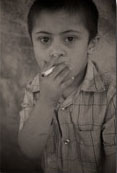
I have seen everything from a youth group practicing traditional dance to a six year old boy that has been addicted to smoking for two years.
I have been asked questions ranging from "Can you help get me a passport to meet my family in Germany?" to "Can you bring this paperwork stating that my husband is infertile to the United States to get medicine so that he will not leave me?"
But most of all, I have seen and experienced a wide range of people, living situations, and attitudes towards life that have left me deeply vested in the future of the people in these camps.
First a little general info
There are four types of displaced people living in Iraq:
Refugees: Officially recognized and documented by the United Nations High Commission for Refugees (UNHCR) as "people who are outside their country of nationality or habitual residence, and have a well-founded fear of persecution because of their race, religion, nationality, membership of a particular social group or political opinion."
Asylum Seekers: Are individuals seeking refugee status from the UNHCR, but have not been officially granted the designation. They generally have the same level of support and rights from the UNHCR as refugees until their application is officially accepted or denied.
Internally Displaced Person: An IDP is someone who has been forced to move from his or her home - in this case due to conflict or persecution - but remains within their country of origin.
Stateless Person: Simply put, "someone who is not considered as a national by ANY state."
In Iraq, there are currently around 2.8 million people displaced in one or more of the above categories. The vast majority, around 2.4 million are internally displaced. However, only about 11% of this number are living in camps or public buildings. The rest are living with families or rented accommodations.
Officially supported by the UNHCR in the Kurdistan region, there are more than 245,000 IDP's, 15,000 Turkish Kurd refugees, 10,000 Iranian Kurd refugees, and 150 Syrian Kurd refugees. More than 1,000 Syrian Kurds are recognized as asylum seekers, with an additional 625 Iranian Kurds.
Makhmoor Refugee Camp
The first camp that I visited, Makmoor, referred to by locals as the "PKK camp," is home to around 11,000 Turkish refugees. While not militant themselves, many openly have ties to the organization. The UNHCR has a policy against supporting anyone that is actively associated with a terrorist organization. However, if they have openly laid down their weapons and become a peaceful people, the organization will support them.
After a short drive through the dust filled town of Makhmoor, about 45 minutes from Erbil, my translator, Leo, and I came upon the large security barriers that formed a maze before coming to the first guard. I promptly got yelled at for taking a photo of the UNHCR flag at the gate, which led to a traditional Kurdish yelling match in which I can never quite tell who is winning. Until, invariably, whoever I am with will turn to me and say "OK. Everything is OK."
Inside, we were greeted by a hesitant Director that said he had no idea how we were granted access to visit the camp. It was not until I found out that the Director's name was Ahmed Dizayee that his attitude changed. Once I told him that I am friends with the miracle Kurd and his family I was immediately treated as a welcomed guest. The Director proceeded to talk to me for an hour about the history of the camp and the people there.
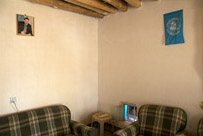 After the talk, we were introduced to a representative of the people in the camp. He took us to the next building where we sat and had our third or forth glass of tea for the day - one that definitely would not be the last. I looked around the largely empty room that I was now in - a few couches, a hole in the wall for the air conditioner, and only two things on the wall: a UNHCR flag and a picture of the former PKK leader Abdullah Ocalan. When I told this to Charles Lynch, the Director of UNHCR operations in Northern Iraq, he was visibly surprised and ceased to go into any further details other than "I didn't know that was there. They definitely shouldn't being doing that."
After the talk, we were introduced to a representative of the people in the camp. He took us to the next building where we sat and had our third or forth glass of tea for the day - one that definitely would not be the last. I looked around the largely empty room that I was now in - a few couches, a hole in the wall for the air conditioner, and only two things on the wall: a UNHCR flag and a picture of the former PKK leader Abdullah Ocalan. When I told this to Charles Lynch, the Director of UNHCR operations in Northern Iraq, he was visibly surprised and ceased to go into any further details other than "I didn't know that was there. They definitely shouldn't being doing that."
Unfortunately, by the time we got through all the formalities and began walking around the camp it was noon. For those of you that haven't been to the Middle East, at noon... it's hot. During midday most people stay inside their homes, and at that time of day, walking around the camp was eerily like walking around a surprisingly well developed ghost town. The camp was actually nicer than most villages that I have visited in the region.
Since no one was outside, I asked if we could visit a family. We were quickly invited into the home of Siso Saleem, a 55 year old father of eight. Sensing my surprise about the number of kids, he instantly responded with, "We must have many children. Some to end up in Turkish prisons, some to join the PKK, some to be educated, and some to take care of the home."
When Mr. Saleem first came to Makhmoor in 1998, he worked as a laborer for $0.20 a day. Since then, through saving and with the help of the UNHCR and the Kurdistan Regional Government (KRG), he was able to build his family a home - something that took three phases to complete.
His wife and two daughters proceeded to lay out a large feast of rice and vegetables. Again in portions that surprised me as not the stereotypical image of a refugee camp.
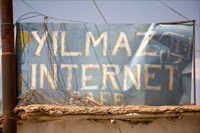 The majority of the development of the camp has happened within the last several years through the help of the UNHCR and the KRG. The camp is still growing at a rate of 100-200 people a year, plus around 300 new births. Each new family is required to build their own home, but the community now supplies the tools and supports in the construction. The camp has five schools and it's own hospital.
The majority of the development of the camp has happened within the last several years through the help of the UNHCR and the KRG. The camp is still growing at a rate of 100-200 people a year, plus around 300 new births. Each new family is required to build their own home, but the community now supplies the tools and supports in the construction. The camp has five schools and it's own hospital.
When I asked if they want to go back to Turkey, they say that they of course do, however they have a list of demands. These include: full amnesty for past activity, their POW's in Turkey released, villages reconstructed, and the rights to teach their schools in Kurdish. In other words, it looks like Makhmoor is not going away anytime soon.
Grdachal Refugee Camp
The Grdachal camp was the complete polar opposite to Makhmoor. Twenty-two families consiting of more than 120 people living in a old converted school house, Grdachal is a stark alternative to their former lives in Iran. The residents of this camp were forced to flee Iran around 1980 and lived for 20 years in mountainous border regions fighting the Iranian government. Now, they have no possibility of ever returning and a bleak future at Grdachal.
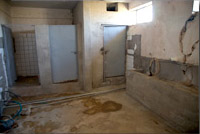 Unlike the people at Makhmoor, the refugees at Grdachal have lost hope. When asked what they wanted, they didn't even have a trace of ambition. They responded only with, "We don't know anymore. All we know is that we want a better life than here." They complained about the facilities (in one case, four families are forced to share the old schoolyard bathroom - a room that smelled so bad I almost had to immediately walk out) and they talked about how they do not even have the opportunity to work because they are located too far from any city.
Unlike the people at Makhmoor, the refugees at Grdachal have lost hope. When asked what they wanted, they didn't even have a trace of ambition. They responded only with, "We don't know anymore. All we know is that we want a better life than here." They complained about the facilities (in one case, four families are forced to share the old schoolyard bathroom - a room that smelled so bad I almost had to immediately walk out) and they talked about how they do not even have the opportunity to work because they are located too far from any city.
Tara Saifulla, 17, sat quietly in the corner next to her mother as my translator interpreted what the men of the camp were saying. Finally, a soft "Please, may I speak?" came from Tara. She had learned english by reading a dictionary and watching TV. I was visibly surprised as she had been sitting there silent for at least 30 minutes. She proceeded to tell me of their plight in no uncertain terms and then told me of her mother and her need for a heart surgery that is not possible in Iraq. They openly asked for my help, and I have since spoken to several people about her mother's case. However, every humanitarian organization that I have spoken to which provides heart surgeries do not even want to look at her case because she is 33 years old - after 18 the success rate is too slim.
Moqoble Refugee Camp
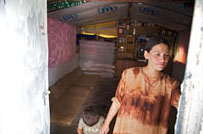 After these two camps, I decided that it was time to return to Dohuk and to the camp that I initially visited during my trip last summer. Moqoble Refugee camp was established in 2004 for Syrian Kurds. I will get into their story in more detail in my next post, but Syrian Kurds by far are faced with the worst situation of all the Kurdish region. Currently, there are over 200,000 stateless Kurds living in Syria without citizenship or any rights.
After these two camps, I decided that it was time to return to Dohuk and to the camp that I initially visited during my trip last summer. Moqoble Refugee camp was established in 2004 for Syrian Kurds. I will get into their story in more detail in my next post, but Syrian Kurds by far are faced with the worst situation of all the Kurdish region. Currently, there are over 200,000 stateless Kurds living in Syria without citizenship or any rights.
The Moqoble Camp consists of more than 40 families that arrived after July of 2004. They live in winterized tents, or tents with cinderblock walls to make it livable during the winter season.
It was at this camp that I saw the six year old smoker and was asked the questions "Can you help get me a passport to meet my husband in Germany?" and "Can you bring this paperwork stating that my husband is infertile to the United States to get medicine so that he will not leave me?"
Again, the cause of the Syrian Kurds is something that I would like to talk about in much more detail, so I will hold off on this camp until the next post.
Azadi IDP / Refugee Camp
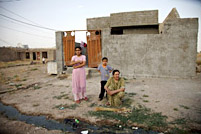 The Azadi camp is composed of many different people. Originally a training area for Saddam's army, the houses have since been converted to homes for Internally Displaced People (IDP's) from cities such as Mosul and Baghdad, as well as many outlying towns and villages. Toward the back of the Azadi Camp are 88 houses that were built for the original arrivals at the Moqoble Camp.
The Azadi camp is composed of many different people. Originally a training area for Saddam's army, the houses have since been converted to homes for Internally Displaced People (IDP's) from cities such as Mosul and Baghdad, as well as many outlying towns and villages. Toward the back of the Azadi Camp are 88 houses that were built for the original arrivals at the Moqoble Camp.
While not quite to the level of development of Makhmoor, this camp still was much closer to the feeling of a small village.
Grdasin IDP Camp
Grdasin was established in April of 2006 for Kurdish people forced to leave their homes in Mosul due to increased threats and violence. At it's height, the camp was home to over 200 families. Now hovering around 100 families consisting of over 800 people, the camp is little more than a temporary solution at best. It is comprised of a mashup of tents and simple cinderblock construction. Small gardens for fresh vegetables line the sides of these simple homes. Conditions within the camp lead to frequent illnesses, especially among the the children and elderly. And employment is again hard to come by as the camp is located far outside any major city.
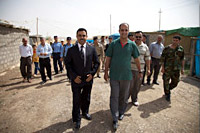 My visit here was an interesting experience in itself. Sirwan Dizayee, Kamiran the Miracle Kurd's brother and General Manager of the Erbil Governorate, once again made a call on my behalf to the local mayor to secure access. When I arrived at the camp, the mayor was there waiting with four armed guards that quickly turned into an entourage of about 20 people. All following me throughout the streets of the camp and waiting as I walked in and out of people's single room homes. It was quite the spectacle.
My visit here was an interesting experience in itself. Sirwan Dizayee, Kamiran the Miracle Kurd's brother and General Manager of the Erbil Governorate, once again made a call on my behalf to the local mayor to secure access. When I arrived at the camp, the mayor was there waiting with four armed guards that quickly turned into an entourage of about 20 people. All following me throughout the streets of the camp and waiting as I walked in and out of people's single room homes. It was quite the spectacle.
Update on the Dizayee Tribe
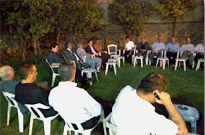 Under unfortunate circumstances - a member of the tribe recently passed away - I finally met the chief of the miracle kurd's branch of the Dizayee tribe. It was an amazing experience. I walked into the grassy yard of the chief's home - a large rectangular space lined on all four sides with plastic lawn chairs - each filled with a member of the tribe. Immediately everyone stood up as I walked around the rectangle shaking each one's hand. I was then escorted to the position of honor - the seat next to the chief of the tribe.
Under unfortunate circumstances - a member of the tribe recently passed away - I finally met the chief of the miracle kurd's branch of the Dizayee tribe. It was an amazing experience. I walked into the grassy yard of the chief's home - a large rectangular space lined on all four sides with plastic lawn chairs - each filled with a member of the tribe. Immediately everyone stood up as I walked around the rectangle shaking each one's hand. I was then escorted to the position of honor - the seat next to the chief of the tribe.
It was fascinating to see the intricacies of the respect system that has been established centuries ago within their family. While the chief of the family has been a farmer all of his life, he was surrounded by doctors, lawyers, and even the Kurdistan Minister of Justice. Yet, all the reverence within the community still fell upon the chief. There was a clear hierarchy however, or at least clear levels of respect.
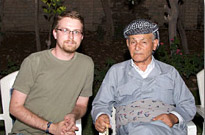 Anytime a new member of the tribe entered, they were either greeted with a simple wave from the rectangle, or if a certain age or social position, everyone would immediately stand. For the Kurdistan Minister of Justice, they immediately stood. And, when he tried to make a quick exit, about 10 Dizayees scurried after him. No doubt to pay some sign of respect or arrange some kind of inner tribe business deal. I have a distinct feeling that a lot of business is conducted, and stays, within the family...
Anytime a new member of the tribe entered, they were either greeted with a simple wave from the rectangle, or if a certain age or social position, everyone would immediately stand. For the Kurdistan Minister of Justice, they immediately stood. And, when he tried to make a quick exit, about 10 Dizayees scurried after him. No doubt to pay some sign of respect or arrange some kind of inner tribe business deal. I have a distinct feeling that a lot of business is conducted, and stays, within the family...
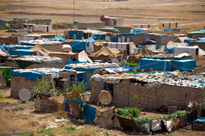
All images and content © 2010 Jon Vidar. All rights reserved. Web site made possible by Movable Type, PhotoShelter, and Media Temple.

Leave a comment